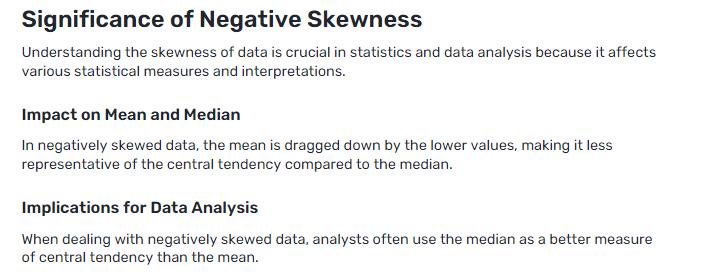Skewness is a key estimation used to check the unevenness of a dataset's scattering. When a dataset has a negative skewness, it suggests that the tail of the scattering is longer on the left side, it is centred around the right side to show that the data. This skewness can essentially influence the translation of focal inclination estimates like the mean, middle, and mode.
Specifically, negative skewness can make these actions be pulled this way, prompting errors in the general portrayal of the information. Understanding the Definition of Negative Skewness for focal propensity measures is urgent for precisely deciphering and examining datasets. For instance, in an adversely slanted dataset, the mean will be not exactly in the middle since the mean is more delicate to outrageous qualities and exceptions.
Effect of Negative Skewness on Interpretation of Central Tendency Measures
Negative skewness in a dataset can essentially affect the translation of focal propensity estimates like the mean, middle, and mode.
Mean
When a dataset is adversely slanted, it implies that the tail of the dissemination is longer on the left side. This will bring about the mean being pulled towards the lower values in the dataset. As such, the mean will be not exactly in the middle in an adversely slanted dispersion. This happens in light of the fact that the super low qualities in the left tail of the dispersion affect the mean than the high qualities on the right side.
For instance, in a dataset of family livelihoods, in the event that there are a couple of very low-pay families, the mean pay will be lower than the middle pay because of the negative skewness brought about by these exceptions. For this situation, the mean may not precisely address the regular pay level of the families in the dataset.
Median
The median is one more proportion of focal propensity that can be impacted by bad skewness in a dataset. In an adversely slanted dispersion, the median will be nearer to the right half of the conveyance, where most of the information focuses are concentrated. This is on the grounds that the median is worth that partitions the dataset into equivalent parts, so it is less affected by outrageous qualities in the tails of the appropriation.
For instance, in a dataset of grades where a couple of understudies scored very low, the median score will be less impacted by these exceptions than the mean score. The median will give a more representative proportion of the run-of-the-mill test score for this situation, particularly while managing slanted information.
Mode
The mode is the worth that shows up most often in a dataset and is one more proportion of focal propensity. In an adversely slanted conveyance, the mode will be not exactly the middle and the mean, as it addresses the most widely recognized esteem in the dataset. Nonetheless, at times, an adversely slanted conveyance might have numerous modes, making it harder to decipher the focal inclination of the information.
For instance, in a dataset of month-to-month precipitation sums, in the event that there are various tops in the conveyance because of various weather conditions, the mode may not precisely mirror the normal precipitation sum. For this situation, the mode may not be a solid proportion of focal inclination, particularly when the information is adversely slanted.
Steps to Include Gauth for Handling Questions
Gauth is here to help you with dealing with your interests quickly and successfully. By following these direct advances, you can use Gauth to find the reactions you truly need rapidly.

Stage 1: Enter the Question
In the first place, you truly need to enter your question into the Gauth search bar. Whether you're looking for information on a specific subject, or searching for the stanzas to a tune, Gauth can help you find what you're looking for.
Stage 2: Wait for Processing
Then, at that point, you'll need to believe that Gauth will manage your query. This may simply require two or three minutes, yet depending upon the complexity of your request, it could require greater investment.
Stage 3: Receive Results
At the point when Gauth has wrapped up dealing with your request, you'll be given the results. Whether it's an immediate reaction, an overview of focal points for extra assessment, or a little-by-little response for an issue, Gauth will outfit you with the information you truly need to push ahead.
Final Talk
Negative skewness can vigorously influence the translation of focal propensity estimates like the mean, middle, and mode in a dataset. The presence of negative skewness shows that the tail of the dispersion is slanted to one side, pulling the mean towards lower values than the middle and mode. This can prompt a distortion of the typical worth in the dataset and influence the general comprehension of the information.


